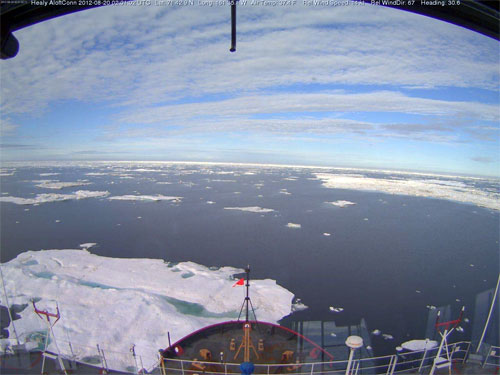
Arctic sea ice breaks lowest extent on record
September 04, 2012
Scattered ice floes are seen from the bridge of the USCGC Healy on August 20, 2012 northwest of Barrow, Alaska. Arctic sea ice fell to its lowest daily extent in the satellite record on Sunday, August 26, 2012.
"By itself it's just a number, and occasionally records are going to get set," NSIDC research scientist Walt Meier said about the new record. "But in the context of what's happened in the last several years and throughout the satellite record, it's an indication that the Arctic sea ice cover is fundamentally changing." According to NSIDC Director Mark Serreze, "The previous record, set in 2007, occurred because of near perfect summer weather for melting ice. Apart from one big storm in early August, weather patterns this year were unremarkable. The ice is so thin and weak now, it doesn't matter how the winds blow." "The Arctic used to be dominated by multiyear ice, or ice that stayed around for several years," Meier said. "Now it's becoming more of a seasonal ice cover and large areas are now prone to melting out in summer." The sea ice cap naturally grows during the cold Arctic winters and shrinks when temperatures climb in the spring and summer. But over the last three decades, satellites have observed a 13 percent decline per decade in the minimum summertime extent of the sea ice. The thickness of the sea ice cover also continues to decline. "The persistent loss of perennial ice cover -- ice that survives the melt season -- led to this year's record summertime retreat," said Joey Comiso, senior research scientist at NASA's Goddard Space Flight Center in Greenbelt, Md. "Unlike 2007, temperatures were not unusually warm in the Arctic this summer." The new record was reached before the end of the melt season in the Arctic, which usually takes place in mid- to late-September. Scientists expect to see an even larger loss of sea ice in the coming weeks. "In 2007, it was actually much warmer," Comiso said. "We are losing the thick component of the ice cover. And if you lose the thick component of the ice cover, the ice in the summer becomes very vulnerable." In 2007, Arctic sea ice extent reached an all-time low in the satellite record that began in 1979. Arctic sea ice follows an annual cycle of melting through the warm summer months and refreezing in the winter. While Arctic sea ice extent varies from year to year because of changeable weather conditions, ice extent has shown a dramatic overall decline over the past thirty years. The pronounced decline in summer Arctic sea ice over the last decade is considered a strong signal of long-term climate warming. With two to three weeks left in the melt season, NSIDC scientists anticipate that the minimum ice extent could fall even lower.
Edited by Mary Kauffman, SitNews
Sources of News:
E-mail your news &
photos to editor@sitnews.us
|
||
